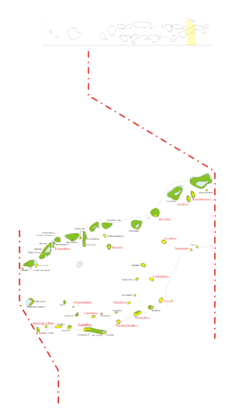Shaviyani Atoll | |
|---|---|
 | |
 Location of Shaviyani in Maldives | |
| Country | Maldives |
| Corresponding geographic atoll(s) | Miladhunmadulu Uthuruburi |
| Location | 6°30' N and 5°58' N |
| Capital | Funadhoo |
| Population | |
• Total | 12,091 noofislands=51 |
| Letter code | C |
| Dhivehi letter code | Sh (ށ) |
| • Inhabited islands | Bileffahi * Feevah * Feydhoo * Foakaidhoo * Funadhoo * Goidhoo * Kanditheemu * Komandoo * Lhaimagu * Maaungoodhoo * Maroshi * Milandhoo * Narudhoo * Noomaraa |
| • Uninhabited islands | Bis Huraa, Dhigu Rah, Dhiguvelldhoo, Dholhiyadhoo, Dholhiyadhoo Kudarah, Dhonveli-huraa, Ekasdhoo, Eriyadhoo, Farukolhu, Fushifarurah, Gaakoshinbi, Gallaidhoo, Hirubadhoo, Hurasfaruhuraa, Kabaalifaru, Keekimini, Killissafaruhuraa, Kudalhaimendhoo, Madidhoo, Madikurendhdhoo, Mathikomandoo, Medhurah, Medhukunburudhoo, Migoodhoo, Naainfarufinolhu, Nalandhoo, Naruibudhoo, Neyo, Vagaru, Firubaidhoo, Maakadhoodhoo |
| Resort islands(*), airports(¤) and industrial islands are also considered uninhabited. | |
Shaviyani Atoll, which is known by its abbreviated name [1] (also known as Northern Miladhunmadulu Atoll or Miladhunmadulu Uthuruburi), is an administrative division of the Maldives. It corresponds to the northern section of the natural Miladhunmadulu Atoll, [2] located in the north of the Maldives.

